 Image search results - "memorial" Image search results - "memorial" |

Entrance to Iimoriyama Hill, site of the Byakkotai "White Tiger" Battalion gravesite. In 1868, a unit of teenage warriors called Byakkotai (White Tiger Battalion) fought against the Emperor-backed Imperial forces encroaching their domain of Aizu
|
|

Former Hatano residence and birth home of Yoshida Togo 旧旗野邸 (吉田東伍生家)
|
|

The Byakkotai were outnumbered and forced to retreat. Twenty of them escaped to Iimoriyama Hill where they saw what looked liked a burning Tsurugajo Castle. Photo: Pay a small fee to take the escalator up the hill. Or climb up the steps for free.
|
|

Rear view of birth home of Yoshida Togo who was a famous geographer of Japan who compiled an encylopedia of Japanese place names. His son was Yoshida Chiaki who composed the melody of the song "Biwako Shuko no Uta" (Lake Biwa Rowing Song).
|
|

In despair, the boys decided to kill themselves rather than die in the hands of the enemy. Photo: Escalator to go up Iimoriyama Hill.
|
|

A room in the birth home of Yoshida Togo
|
|

Escalator to go up Iimoriyama Hill. Their tombstones are on this hill near where they killed themselves. Their story has become legend.
|
|

Garden of the birth home of Yoshida Togo
|
|

Byakkotai Gravesite. It is on a flat area which also has several other Byakkotai monuments including those from other countries.
|
|

Entrance to the Yoshida Togo Memorial Museum which exhibits various documents and personal effects of Yoshida Togo. Museum admission 300 yen. Closed Mon.
|
|

Approach to the Byakkotai gravesite.
|
|

Inside Yoshida Togo Memorial Museum. The 2nd floor also has a display panel about his son Yoshida Chiaki who composed the song "Hitsuji-gusa" whose melody was used in the song "Biwako Shuko no Uta" (Lake Biwa Rowing Song).
|
|
|
|

Graves of the 19 teenage Byakkotai warriors who killed themselves with their own swords.
|
|

Byakkotai Graves
|
|

Byakkotai Graves
|
|

Byakkotai gravestones. Each one shows the name, age, and method of death called "jijin" (died with one's own sword 自刃).
|
|
|

This has become a national shrine, almost as important as Sengakuji where the 47 masterless samurai are buried.
|
|
|
|
|
|

On the right side are more gravestones. These are 31 Byakkotai members who died in battle. 戦死
|
|

Tombs of those Byakkotai who died in action.
|
|

Tombs of those Byakkotai who died in action.
|
|

Their names, age, and "senshi" 戦死 (died in battle) are engraved on the stones.
|
|
|

Monument for teenage samurai who died in battle.
|
|

Names of Byakkotai members, all 14 to 17 years old.
|
|

On the left of the gravestones, there is a monument for a poem composed by Lord Matsudaira Katamori, the last Aizu lord and whom the Byakkotai died for. 幾人の 涙は石にそそぐとも その名は世々に 朽じとぞ思う幾人の 涙は石にそそぐとも その名は世々に 朽じとぞ思う
Ikutari no namida wa ishi ni sosogu tomo sono na wa yoyo ni kuji to zo omou
"No matter how many people pour their tears on these stones, these names will never fade from the world."
|
|

A short walk away is the grave of Iinuma Sadakichi, the only Byakkotai survivor who had slit himself, but was rescued by a villager passing by when everyone else had killed themselves.
|
|

Grave of Iinuma Sadakichi, the only Byakkotai warrior who survived and told the story of this valiant teenage group.
|
|

Grave of Iinuma Sadakichi (Sadao) (1854-1931). His grave was built here in 1957 for the 90th anniversary of the Byakkotai's demise. 飯沼貞吉
|
|

About Iinuma Sadakichi (later changed his first name to Sadao)
|
|

Slope where they committed seppuku (hara-kiri). 自刃の地
|
|

Site where they committed seppuku (hara-kiri). 自刃の地
|
|
|
|
|
|
|
|
|
|

A recent addition is this statue of a teenage samurai looking at Wakamatsu Castle.
|
|

Statue of a teenage samurai looking at Wakamatsu Castle.
|
|
|
|

Statue faces Tsuruga-jo Castle which can be seen in the distance.
|
|

Arrow points to Tsuruga-jo Castle.
|
|
|

Byakko Kannon statue
|
|
|
|

Monument from Rome, Italy, given in 1928 by Mussolini. The column is from the ruins of a palace in Pompeii.
|
|

Monument message in Italian. After WWII, the US Occupation authorities wanted this monument removed. But all they did was remove the engraved message (later restored).
|
|

About the monument from Rome.
|
|

Monument from a German, Hasso von Etzdorf (1900 - 1989).
|
|

Another monument
|
|

Opened in 1956, the Byakkotai Memorial Museum has numerous artifacts related to the Byakkotai as well as the Shinsengumi. Photography inside is not allowed. Admission 400 yen.
|
|

Byakkotai statue outside the Byakkotai Memorial Museum
|
|
|
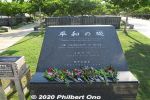
Cornerstone of Peace (平和の礎) in Mabuni, a large oceanfront memorial park full of these stone slabs inscribed with over 240,000 names of people who died in the battle.
|
|
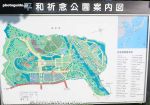
Map of Cornerstone of Peace witin the Okinawa Peace Prayer Park.
|
|
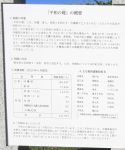
About the Cornerstone of Peace. http://www.peace-museum.pref.okinawa.jp/
|
|
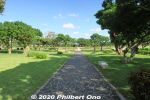
Walking to the Cornerstone of Peace.
|
|

Peace Prayer Memorial Hall in the Okinawa Prefectural Peace Park.
|
|
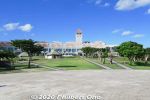
Okinawa Prefectural Peace Memorial Museum (沖縄県平和祈念資料館)
|
|
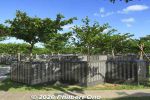
Stone slabs inscribed with over 240,000 names of people who died in the battle. Civilians and military, Japanese and foreign.
|
|
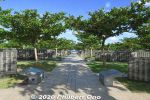
Japanese victims are inscribed by prefecture. Foreign nationals are inscribed by country.
|
|
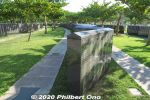
Stone slabs are like folding screens in a slight zig-zag pattern.
|
|
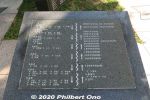
Map of where people's names are inscribed. Okinawans are inscribed according to their hometowns. Nearby are also war memorials for each prefecture.
|
|
|
|
|
|
|
|

Flame of Peace at the center of the Peace Plaza on the oceanfront. 平和の火
|
|
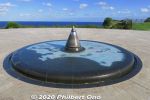
Flame of Peace in the world map. 平和の火
|
|
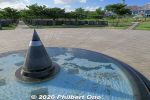
Flame of Peace in the world map. Japan can be seen in the map. 平和の火
|
|
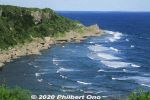
Mabuni Cliff
|
|
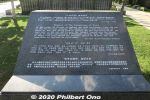
About the Cornerstone of Peace.
|
|
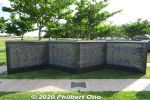
Names of 14,000+ Americans who died in Okinawa.
|
|
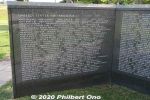
Names of 14,000+ Americans who died in Okinawa.
|
|
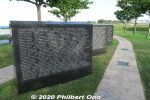
Slabs for 14,000+ Americans who died in Okinawa.
|
|
|
|
|
|
|
|
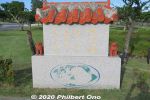
"Life is a Treasure..."
|
|
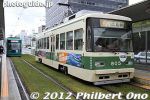
Street car stop nearest to the Hiroshima Peace Memorial Park. Hiroden Genbaku Dome-mae Station. Hiroshima is one of the few Japanese cities which still has street cars.
|
|
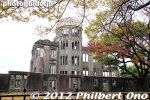
Right near the streetcar stop is the Atomic Bomb Dome or A-Bomb Dome (原爆ドーム). I visited in fall 2012.
|
|
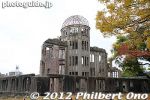
Built in 1915, it was the Hiroshima Prefectural Industrial Promotion Hall.
|
|
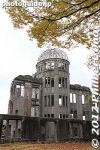
The atomic bomb fell almost directly above this building on Aug. 6, 1941 at 8:15 am.
|
|
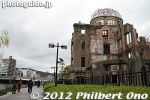
The Atomic Bomb Done was designated a UNESCO World Heritage Site in 1996.
|
|
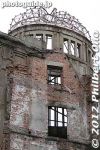
I think all Americans visiting or living in Japan should visit Hiroshima. It's not about who's to blame for what happened here in Aug. 1945. It's about a major event in human history and a reminder of man's fatal flaws.
|
|
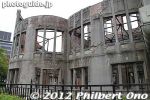
Notice the steel braces to reinforce the building.
|
|
|
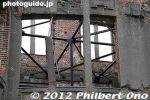
Notice the steel braces to reinforce the building.
|
|
|
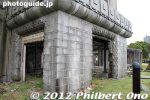
We can get quite close to the building, but it is fenced off so we cannot enter it.
|
|
|
|
|
|
|
|
|
|
|
|
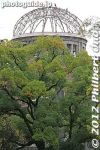
Hiroshima Atom Bomb Dome
|
|
|
|
|
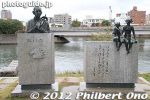
Monuments abound in the Peace Park. In the background is Aioi Bridge, the original target of the atomic bomb.
|
|
|
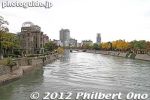
View from Aioi Bridge.
|
|
|
|
|
|
|
|
|
|
|
|
|
|
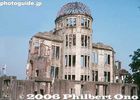
Atomic Bomb Dome
|
|
|
|
|
|
|
|
|
|

Peace Clock Tower
|
|

Peace Clock Tower
|
|
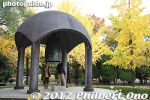
Peace Bell. Peace Bell. Anyone can ring it for free.
|
|

About the Peace Bell
|
|
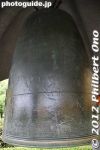
Hiroshima Peace Bell
|
|
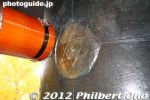
Hiroshima Peace Bell with atom symbol on the sweet spot.
|
|
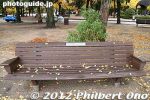
Donated benches.
|
|

Donors of benches.
|
|
|
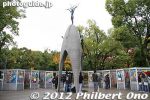
Children's Peace Monument dedicated to the memory of the children who died as a result of the bombing.
|
|

Children's Peace Monument
|
|

Children's Peace Monument before they built origami crane shacks around it.
|
|
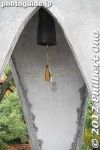
Bell in Children's Peace Monument.
|
|
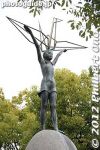
Children's Peace Monument, Hiroshima
|
|
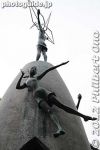
Rear of Children's Peace Monument, Hiroshima.
|
|

About the Children's Peace Monument.
|
|
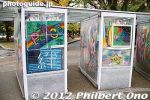
Shacks of origami paper cranes folded by many students from all over.
|
|
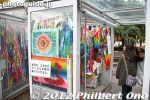
Very colorful and incredible designs.
|
|
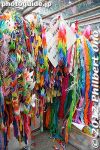
There's a sign indicating where you should hang your origami cranes.
|
|
|
|
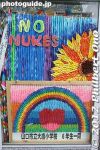
Hiroshima
|
|
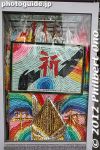
Pictures made of origami at Hiroshima Peace park.
|
|
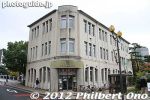
Another building that survived the atom bomb. Now a rest house and tourist information center. Hiroshima.
|
|

About the rest house.
|
|
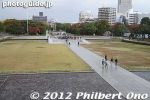
This is where the Hiroshima Peace Memorial Ceremony is held on Aug. 6 in the morning. The service is open to the public for free and you can sit if you get there early enough in the morning. Otherwise, you can stand in the back amid the sweltering heat.
|
|
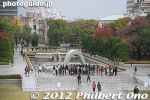
Memorial Cenotaph
|
|
|

Memorial Cenotaph
|
|
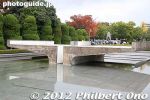
Peace Flame aligned with the Cenotaph and Atomic Bomb Dome.
|
|
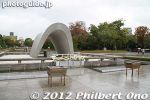
Memorial Cenotaph
|
|
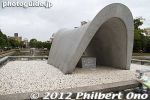
Memorial Cenotaph
|
|
|
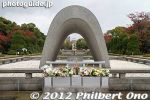
The Peace Park's focal point is this Memorial Cenotaph. It stores the names of all of the people killed by the bomb. The monument frames the Peace Flame and the A-Bomb Dome in a straight line.
|
|
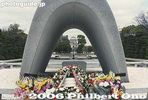
One of the Japan's best-designed memorials.
|
|
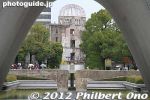
Atomic Bomb Dome as seen from the Cenotaph.
|
|
|
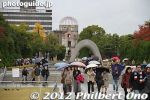
At least one blessing from the bomb is the endless stream of tourists coming to Hiroshima.
|
|

About the Hiroshima Peace Memorial Park.
|
|

Peace Flame and Hiroshima Peace Memorial Museum
|
|
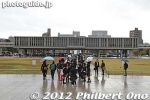
Hiroshima Peace Memorial Museum
|
|
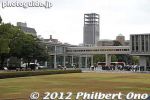
Hiroshima Peace Memorial Museum's East Wing built in 1994.
|
|
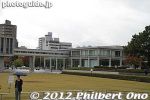
International Conference Center Hiroshima is also attached to the museum.
|
|
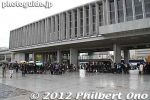
Main building of the Hiroshima Peace Memorial Museum with various exhibits explaining about the bombing and its effects. You also see many personal belongings mangled, melted, or tattered by the blast. Hordes of students on class trips from all over JapanHiroshima Peace Memorial Museum
|
|
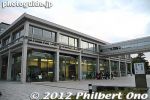
Hiroshima Peace Memorial Museum's East Wing built in 1994. You enter the museum through this building. Admission is only 50 yen for adults (30 yen for students).
|
|
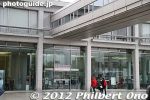
Entrance to Hiroshima Peace Memorial Museum through the East Wing. It has a lot of exhibits and can take a while to go through it if you want to read everything
|
|
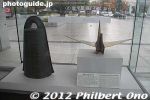
Original bell and origami sculpture for the Children's Peace Monument.
|
|

The East Wing explains the history of Hiroshima city before the bomb, development and decision to drop the bomb, the lives of Hiroshima citizens during World War II.
|
|
|
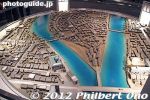
What central Hiroshima looked like before the bomb. The building that would become the Atomic Bomb Dome is on the lower left with the light green roof.
|
|
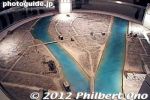
And how it looked after the bomb. The Peace Park is on the land in the center between the two rivers. The Atomic Bomb Dome is on the lower left.
|
|
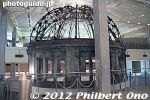
Scale model of the Atomic Bomb Dome.
|
|
|
|
|
|
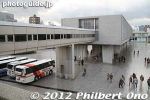
Corridor to the museum's main building or West Wing.
|
|
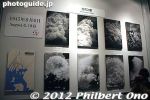
Photos of the atom bomb blast.
|
|
|
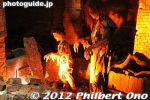
Mannequins depicting bomb victims who suffered peeling/melting skin among other things. This depiction has been toned down considerably from the original exhibit that I remember before the museum was renovated in 1994.
|
|
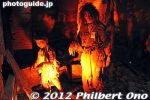
The original exhibit showed a much more horrific faces and disfigurement with peeling skin down to their knees at least. I heard that they didn't want to make it too scary for children. Too bad.
|
|
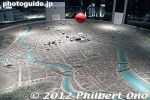
Orange ball shows where the bomb fell.
|
|

Atomic Bomb Dome area.
|
|
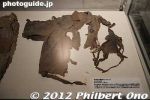
Tattered clothing from a 13-year-old girl who died in the evening on the day of the bomb.
|
|
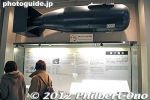
Life-size replica of the Hiroshima bomb, nicknamed "Little Boy." It's about 3 meters long.
|
|
|

Tricycle
|
|

About the tricycle.
|
|
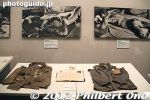
Grisly photos and tattered clothing.
|
|
|
|
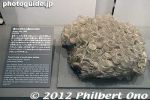
Glass bottles melted together.
|
|
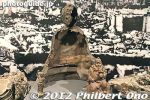
Damaged Buddha statue.
|
|
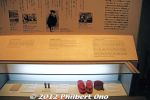
About Sadako.
|
|
|
|
|
|
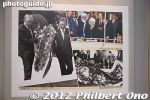
President Jimmy Carter visited Hiroshima after he left office.
|
|
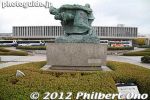
Front of the Hiroshima Peace Memorial Museum (opposite side from the Cenotaph) and Statue of Mother and Child in the Storm.
|
|
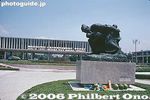
Atomic Bomb Museum and Statue of Mother and Child in the Storm.
|
|
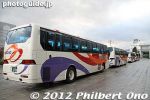
Many buses in front of the museum.
|
|
|
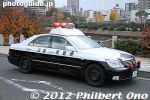
Hiroshima police car.
|
|
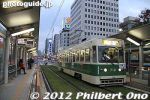
Streetcar station near Hiroshima Atomic Bomb Dome.
|
|

Sightseeing map of Kawajima town in Saitama Prefecture. Looks like it has a lot to see.
|
|
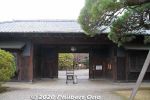
Entrance to Toyama Memorial Museum (遠山記念館).
|
|
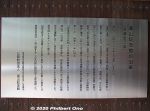
About Toyama Memorial Museum (遠山記念館).
|
|
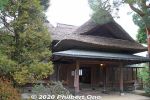
Toyama Memorial Museum (遠山記念館) has this thatched-roof home built in 1936 by Kawajima-native Toyama Gen'ichi (遠山元一 1890–1972), the founder of Nikko Securities. It was a home for his mother.
|
|
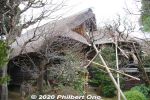
The home has three wings, this wing witth a thatched roof is designed like a farmhouse.
|
|

This West Wing part of the house is desiged like a tea ceremony room.
|
|
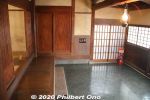
Entrance hall has this rare stone tiles on the floor.
|
|
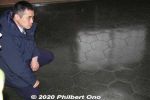
Entrance hall has this rare stone tiles on the floor.
|
|
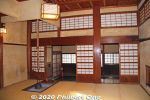
Farmhouse room.
|
|
|
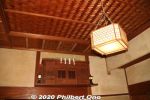
Shinto shrine altar near the fancy ceiling.
|
|
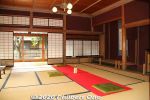
Japanese-syle room in the West Wing.
|
|
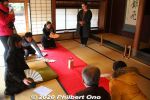
We tried playing a traditional fan-tossing game called tosenkyo (投扇興). You toss a folding fan at a small target on a small block.
|
|
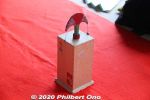
Called "cho" (butterfly), the target is shaped like a gingko leaf. The number of points you earn depends on how well you knock down the target.
|
|
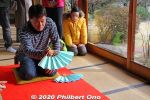
Our tosenkyo instructor takes aim.
|
|
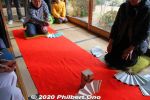
It's quite hard for beginners to even knock it down because the fan tends to fly in unpredictable directions.
|
|
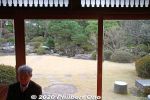
The imported glass was also expensive.
|
|
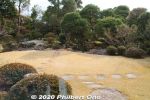
Garden
|
|
|
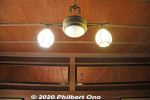
Very rare Yaku-sugi wood ceiling from Japanese cedar trees found on Yakushima island in Kagoshima Prefecture. Beautiful wood grain.Such wood comes from trees as old as 1,000 years. Now illegal to cut down yaku-sugi trees. 屋久杉
|
|
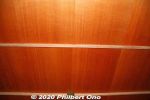
Straight-line wood grain on another ceiling.
|
|

Tokonoma alcove.
|
|
|
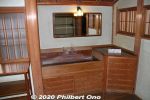
Bathroom sink.
|
|
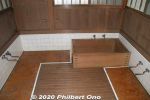
Bath tub
|
|
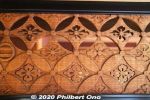
Transom
|
|
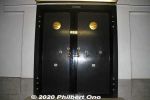
Storehouse door, fireproof.
|
|
|
|
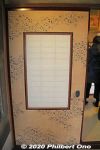
Fusuma sliding door.
|
|
|
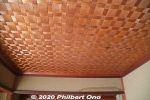
Fancy ceiling.
|
|
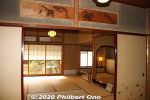
Tea ceremony room.
|
|
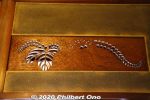
Transom with a paulownia design.
|
|

Tea ceremony room alcove.
|
|
|
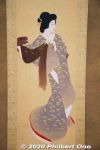
Scroll depicting a woman dancer with a lion head.
|
|
|

Tea ceremony room.
|
|
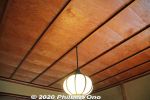
Very rare Yaku-sugi wood ceiling from Japanese cedar trees found on Yakushima island in Kagoshima Prefecture.
|
|
|
|